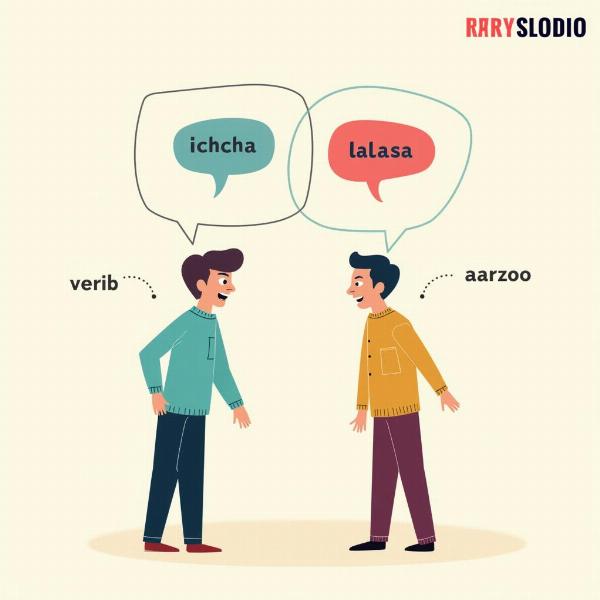Keen desire, a powerful yearning that drives us, translates beautifully into Hindi. While a direct translation might be challenging, capturing the essence is key. “Ichchha” (इच्छा) is the most common and versatile term for desire in Hindi. However, depending on the nuance and intensity, several other words can convey a “keen desire,” enriching the understanding of this complex emotion.
Understanding “Ichchha” and its Nuances
“Ichchha” (इच्छा) encompasses a wide range of desires, from simple wishes to profound longings. It’s the foundational word for desire and serves as a starting point for exploring deeper meanings. Think of it as the general term for wanting something, be it a material possession or a more abstract concept like happiness. What sets a “keen desire” apart is the intensity and fervor associated with it.
Expressing Keen Desire in Hindi: Beyond “Ichchha”
Several Hindi words beautifully capture the nuances of a keen desire, each adding a layer of meaning to the basic concept of “ichchha.” Let’s explore some of these:
-
Lalasa (लालसा): This word describes a craving, a strong desire often associated with material possessions or sensual pleasures. It suggests a yearning that is difficult to resist.
-
Talah (तलब): “Talah” describes an intense craving, often used in the context of addiction or a deep-seated longing for something specific. It carries a sense of urgency and desperation.
-
Aarzoo (आरज़ू): “Aarzoo” represents a heartfelt desire, often a cherished wish or a long-held aspiration. It’s a word often used in poetry and songs to express profound longing.
-
Chah ( चाह): While similar to “ichchha,” “chah” often implies a stronger, more persistent desire. It suggests a deep-seated wish that influences one’s actions and thoughts.
Keen Desire in Indian Culture and Philosophy
The concept of desire plays a significant role in Indian philosophy and spirituality. While desire is seen as a natural human emotion, its unchecked pursuit can lead to suffering. The Bhagavad Gita, a central text in Hinduism, emphasizes the importance of managing desires and detaching from worldly attachments to achieve liberation (moksha). This doesn’t imply suppressing all desires, but rather cultivating a balanced approach, focusing on desires that contribute to personal growth and the well-being of others.
Practical Applications of “Keen Desire” in Hindi Conversations
Knowing how to express “keen desire” in different contexts is crucial for effective communication in Hindi. Here are a few examples:
-
“Mujhe yeh kaam karne ki bohot ichchha hai” ( मुझे यह काम करने की बहुत इच्छा है): I have a strong desire to do this work.
-
“Unhe safalta pane ki lalasa thi” (उन्हें सफलता पाने की लालसा थी): He had a keen desire to achieve success.
 Expressing Keen Desire in Everyday Hindi Conversation
Expressing Keen Desire in Everyday Hindi Conversation
What is the Hindi word for “burning desire”?
A “burning desire” can be expressed using phrases like “atidurghat ichchha” (अतिदुर्घट इच्छा) or “jalti hui ichchha” (जलती हुई इच्छा). These phrases emphasize the intensity and urgency of the desire.
How do you express “keen interest” in Hindi?
“Keen interest” can be expressed using phrases like “ghahri ruchi” (गहरी रुचि) or “teevra ruchi” (तीव्र रुचि). These phrases highlight the depth and intensity of the interest.
Conclusion: Delving Deeper into the Meaning of “Keen Desire” in Hindi
Understanding the nuances of “keen desire” in Hindi goes beyond simple translation. It involves exploring the cultural and philosophical context, as well as the various words that capture the different shades of this powerful emotion. From the foundational “ichchha” to the more intense “lalasa” and “talah,” the Hindi language provides a rich vocabulary to express the depths of human longing. By understanding these nuances, we can gain a deeper appreciation for the complexities of human emotion and communicate more effectively in Hindi.
FAQ:
-
What is the most common Hindi word for “desire”? A: The most common Hindi word for “desire” is “ichchha” (इच्छा).
-
What are some other words to express “keen desire” in Hindi? A: Other words to express “keen desire” include “lalasa” (लालसा), “talah” (तलब), “aarzoo” (आरज़ू), and “chah” ( चाह).
-
How does Indian philosophy view desire? A: Indian philosophy often views desire as a natural human emotion, but cautions against its unchecked pursuit, which can lead to suffering.
-
How do you say “burning desire” in Hindi? A: “Burning desire” can be expressed as “atidurghat ichchha” (अतिदुर्घट इच्छा) or “jalti hui ichchha” (जलती हुई इच्छा).
-
What is the Hindi equivalent of “keen interest”? A: “Keen interest” can be expressed as “ghahri ruchi” (गहरी रुचि) or “teevra ruchi” (तीव्र रुचि).
Meaning-Hindi.in is your one-stop solution for all your Hindi translation needs. We offer a wide range of professional translation services, including business and commercial document translation, certified and legal document translation, technical and user manual translation, website and localization services, educational and academic translation, and fast and urgent translation services. Our team of expert Hindi linguists ensures accurate and culturally sensitive translations for all your requirements. Contact us today at [email protected] or call us at +91 11-4502-7584. Meaning-Hindi.in is here to bridge the language gap and connect you to the world of Hindi.